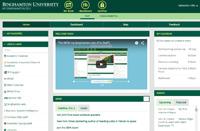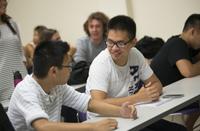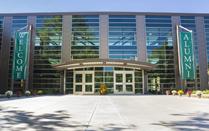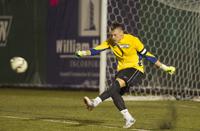Binghamton University President Harvey Stenger's Road Map Quarterly Report - September 30, 2015
Earlier this month, I had the opportunity to attend a ceremony recognizing two Binghamton scholar-athletes. Track & field competitors Kieshorea Armstrong and Jesse Garn competed at the NCAA Championships in June. Kieshorea placed 24th in the women’s long jump, earning Honorable Mention All-American status, while Jesse came in fourth in the men’s 800-meter race to be named First-Team All-American. I was struck by the way both of them spoke about their accomplishments, describing how even though both compete as individuals, it is only through a team effort that they are able to compete on the national stage. I think that their observation is one that applies throughout the University — while so many individuals on campus excel in their work, it is through the combined efforts of our colleagues and supporters that the University continues to gain national recognition.
One of the goals of the Road Map has been to provide a system of supports to help the campus reach its goals. In many ways, these supports are comparable to the training and coaching that our best athletes receive. We work to get the best people here — and then provide them with the tools and experiences that will make them even better. For example, this year we’ve increased funding for the Center for Learning and Teaching, which works with faculty who want to be more effective teachers, and we’ve provided more initial support for new faculty to equip their labs and kick-start their research.
This approach is beginning to strengthen the campus. As we enter the fall semester, the University is gaining a national reputation for academic excellence; for outstanding research and scholarship; and for its local, national, and global impact. We’re attracting better students, promising young faculty and experienced researchers. We have a campus that is growing to meet the needs of students and fostering regional economic development. And we have a plan in place — the Road Map — that ensures that the campus can seize new opportunities as they present themselves. This quarterly report will highlight many of the exciting initiatives and achievements that have occurred over the past three months.
A new academic year
At the end of August we welcomed students back to campus, including 2,570 freshmen and over 1,000 transfer students. Preliminary figures indicate that total enrollment for the 2015 fall semester will be over 16,800 students, up by around 200 students compared to last year. Most of this year’s growth is happening at the graduate level.
One of our chief concerns as we increase our enrollment is to maintain student quality. Fortunately, our growing reputation has translated into a much larger pool of applicants, allowing us to be more selective in those we admit. This year, a record number of high school and transfer students applied for undergraduate admission, even as we were nearing the end of our enrollment increase associated with our NYSUNY 2020 plan. With more than 30,600 freshman applications our admissions staff had many very qualified students to choose from, so that this year’s class is as smart and accomplished as any in the University’s history. The incoming class has an average SAT score of over 1,300 for critical reading and mathematics and holds an average high school GPA of 95.
The student body is also becoming more diverse, both in terms of minority enrollment and geographic distribution. Thirty-nine percent of new students are from upstate New York; 6 percent are from Broome and Tioga counties; 26 percent are from Long Island; and 22 percent are from New York City. We also have about 900 new international students from 45 nations. I am especially pleased that our efforts to enhance diversity are having positive results. In fact, of the approximately 2,300 students we’ve added since 2011, 32 percent self-identify as African American, Hispanic or Native American.
Move-in day went exceptionally well this year. It is always an exciting time, with thousands of parents and family members on campus. This year the campus was especially busy, as move-in day took place in the week before the long Labor Day weekend. This is traditionally the busiest week of the year for campus visits, with more than 3,000 high school students and their families exploring the University. Overall, this summer saw a record number of visitors, with more than 11,500 prospective students and parents visiting between May and August — over 1,000 more guests than visited in the summer of 2014.
We also have welcomed dozens of new faculty to campus. Fifty-seven new tenure-track faculty have joined us this fall, with additions to every school and college. There is an immense variety in the disciplines as well, ranging from art and design and Asian American studies, to psychology, computer science and mechanical engineering. A number of these hires are associated with our Transdisciplinary Areas of Excellence (TAEs), which encourage transdisciplinary research. And, like the students who are new to campus, our faculty, too, are increasingly diverse in their backgrounds. Some are experienced researchers and scholars whose reputations will help attract highly qualified graduate students; others are newly minted PhDs from outstanding universities with promising careers ahead of them. These new faculty, along with our new staff members, contribute to the broad range of ethnic and racial backgrounds that make Binghamton such a welcoming and inclusive place, with the total number of underrepresented minority faculty and staff increasing by nearly 50 percent since 2011.
These were just some of the statistics I highlighted as part of my State of the University address in September. In a change from previous years, I held this event at the beginning of the academic year, instead of in January, in order to allow more students and faculty to attend if they wished. My talk focused on the significant growth that the University has experienced under NYSUNY 2020 and the Road Map, as well as the new directions in research and scholarship that have resulted from the TAEs. Looking ahead, I stressed the need to increase our graduate enrollment and the steps we are taking to support our graduate and research programs.
I also stressed the unique opportunity for graduate growth — and the enormous contributions to the regional economy — that will result from the development of the new Southern Tier Health Sciences Technology Park. The park is the regional centerpiece of the Southern Tier’s Upstate Revitalization generated in response to Gov. Andrew Cuomo’s Upstate Revitalization Initiative that I discussed in last quarter’s report. This proposal, along with the concurrent proposal for Round 4 Regional Economic Development Council funding, will be delivered to Albany next month.
The start of the academic year is also the time when many of the national publications release their annual ranking of colleges and universities. Once again, Binghamton fares very well in the most recognized of these, the U.S. News & World Report rankings, where we placed 37th among public colleges and universities, and in the top 100 among all institutions. These rankings are important as they are both a recognition of our quality and a means of gaining visibility, though I tell people that we take the major rankings with the proverbial grain of salt, as there is much about Binghamton’s quality that these rankings don’t capture.
Recently, there have been a host of new rankings and accolades that try to capture some of these less visible characteristics of colleges and universities. Significantly, we also tend to rank high in these. For example, the organization Greatist, which promotes healthier living, recently ranked us among their top 25 healthiest campuses, based on the quality of our food services, recreational opportunities and healthcare facilities, among other criteria. (We recently appointed Johann Fiore-Conte to a newly-created position, vice president for health and wellness, in order to provide stronger administrative support for a healthy campus). More recently, The New York Times ranked us as a “Top College Doing the Most for Low Income Students,” based on the percentage of Pell grant recipients on campus and their outstanding graduation rates. And Binghamton was the only SUNY campus to be named an “Innovation and Economic Prosperity University by the Association of Public and Land-grant Universities (APLU) for our work with public- and private-sector organizations to promote regional economic development.
While we appreciate the good reviews from our external audiences, I was especially pleased to learn what people who work at Binghamton think about the campus. We recently received the results of the Higher Education Research Institute Faculty Survey that was conducted last year. More than 435 faculty members responded to the survey, so the results are a fairly good barometer of the way faculty view the campus. What stands out for me is the comparison of Binghamton to other highly selective campuses, in that we outdo them in some important ways that contribute to better learning for students and a better work environment. The report also highlights the University’s strong commitment to diversity and civic engagement. All in all, the survey is an important gauge of faculty perceptions, highlighting our strengths as well as areas where we can improve.
Construction news
We also have been working to make physical changes to the campus to improve learning spaces and enhance pedestrian safety. Over the summer, construction work on the Student Wing continued, with the opening of about a dozen new classrooms on the wing’s third floor. These classrooms opened in time for students’ arrival in September; work on the rest of the building will be completed in spring 2016.
Pedestrian safety was the driving force behind changes in the sidewalks located near the Student Wing and Lecture Hall, with new walkways designed to channel pedestrian traffic more directly to clearly defined crosswalks. Similarly, Physical Facilities has removed the berm that was located in the traffic circle on Bartle drive. This berm was a popular place for graduates to take photos as it the planting included the graduation year. We were concerned that students had to contend with traffic to get to the middle of the circle. Following an online vote, the berm will be relocated to the Peace Quad and will be ready for next spring’s graduates.
Scholarship, research and economic development
This past quarter also saw a number of our faculty receive recognition for their scholarship and research activities. Two faculty members in our Department of Political Science, Professor Michael McDonald and Assistant Professor Robin Best, took first place in the “Gerrymander Standard” writing competition sponsored by the non-partisan political lobbying group Common Cause. Their paper proposes a method to identify whether the way congressional districts provides for an “unequal weighting of votes” for one partisan group over another, and compares their standard against several cases of alleged gerrymandering. Professors McDonald and Best will be working with two other political science faculty, professors Jon Krasno and Dan Magleby, to design software that can assist courts, legislatures and districting commissions in drafting “fair” voting districts.
Moving from the political to the personal, Binghamton anthropology research associate Craig E. Morris received a lot of attention in the press for his study published in Evolutionary Behavioral Sciences comparing the effects of breakups on men and women, finding that while women feel the pain more intensely initially after a relationship is ended, men, who may “move on” following the breakup, don’t recover as fully over time.
M. Stanley Whittingham, distinguished professor of chemistry and of materials science, has been named a 2015 Thomson Reuters Citation Laureate – a researcher whose work has achieved quantifiable esteem and impact in the scientific community at a level far beyond the norm. Whittingham has been at Binghamton since 1988, and is the director of the NorthEast Center for Chemical Energy Storage (NECCES) at Binghamton that received a $12.8 million, four-year grant from the United States Department of Energy last year. According to Thomson Reuters, his designation as a laureate signals that he is “of Nobel” class and likely to earn the Nobel someday. We’ll find out if professor Whittingham earns one this year on October 7.
Apart from the individual recognition, the University’s reputation for excellence in research is also generating greater external support. We’ve had two recent announcements that demonstrate the University’s role as a leader in the development of new technologies. First, the University received notice that it will serve as the New York hub of a $75 million, five-year federal initiative to advance flexible hybrid electronics manufacturing. The Flex Tech Alliance, with Binghamton as a founding member, has been chosen as an “Innovation Institute for Flexible Hybrid Electronics Manufacturing.” Partners in the Alliance will receive a share of the funding based on the how quickly they can devise projects and the likelihood of those projects succeeding. New York state members are also eligible to receive matching funding from the state, up to $20 million over five years.
The goal of the Alliance is to help bring university research in flexible electronics to the production stage for the commercial market. For example, Binghamton researchers are looking at ways to create health-monitoring devices, such as bandages that can detect infections, or flexible glass monitors. Binghamton will work with a number of New York state companies and research institutions, including Corning, Inc., i3 Electronics, General Electric and Lockheed-Martin, as well as Cornell University and other SUNY research universities. The Binghamton University node works out of the Center for Advanced Microelectronics Manufacturing (CAMM) located at the Huron campus in Endicott.
We also learned this month that the University’s Integrated Electronics Engineering Center (IEEC) has had its designation as a Center for Advanced Technology (CAT) renewed through Empire State Development. The state of New York developed the CAT program as a way to encourage the successful transfer of technology from university research into commercially viable products. The designation provides for $1 million in support each year for the next 10 years.
The IEEC has been a Center for Advanced Technology since 1991, and works with approximately 90 local and national partner firms, conducting research and testing on behalf of the affiliated companies. The IEEC focuses on electronics packaging, with one of its chief goals being the development and integration of smaller chips that can be assembled into with other parts (or “microelectronics packages”) resulting in smaller consumer devices.
The University also made news with regard to two new firms participating in the START-UP NY program. Currently, there are 14 firms either fully affiliated or with applications pending or in process as part of Binghamton’s START-UP NY efforts. Angelsoft, LLC, doing business as Gust, provides software support for entrepreneurs working to collaborate with investors, while Callsign, Inc., is a company that develops apps that ensure secure communications between individuals and businesses, increasing privacy while reducing the need for passwords. Together these two firms will be adding nearly 50 jobs based out of the University’s Engineering and Science Building. In addition, ChromaNanoTech, also housed at the Innovative Technologies Complex was recently licensed as a member of START-UP NY. Binghamton chemistry professors Wayne Jones and William Bernier, along with chemistry PhD alumnus Ken Skorenko, working with researchers from local dye manufacturer Crysta-Lyn Chemical Company, have launched the firm that produces high-tech pigments that can be used to coat glass, allowing visible light to shine through while limiting the transfer of heat. The product has significant potential applications for passive solar window treatments.
I’m excited about the potential for these and other firms associated with START-UP NY and expect them to soon be contributing to the region’s economic well-being. When the plan was first announced, I felt it would take some time before their impact would be felt, but I strongly believe START-UP NY has the potential to help turn the upstate economy around.
Sincerely,

Harvey G. Stenger






